I got another reply from Brian Baxter at Wellington Regional Council about the lack of space for bikes on commuter trains in Wellington. It sounds like WRC have their hands tied on account of some of the staff at Tranz Metro. I wonder if it's possible to get some change on this issue now that the government owns the trains again --- perhaps if we can get some more publicity for the issue.
Date: 25 July 2008
From: Brian.Baxter@gw.govt.nz
A bit late in replying, but to answer some of your questions:
1. We contract Tranz Metro to run the trains. We pay them about $20m a
year to do so. It was us that prompted (in fact required) the removal
of the carriage charge, but operational issues (such as the number that
can "safely" be carried is their responsibility).
2. I'm interested in your comments about whether or not they use more
than one baggage compartment. I was under the impression that they do,
and certainly their leaflet that they have produced says that there will
be up to 4 compartments available per train.
3. The "trial" period is something Tranz Metro wanted, and the period is
undefined. I haven't pushed the issue of how long it is in case they
say it is only for a month, and then refuse to carry bikes at all! I
have taken the approach so far of keeping quiet about it all, hoping
that the heat will go out of the issue and the guards will go back to
being a bit more helpful/flexible. But I will have to talk to Tranz
Metro again soon to determine where we go to next. I'm not sure about
what consultation process with users will occur, but all the feedback we
are getting has been useful, and will certainly be used.
29 July, 2008
Bikes on trains in the news
We managed to get a bit of attention for the isue of bikes on trains last week with the following appearing in a couple of regional papers:
A two cycles per unit restriction has "undone" any benefits from scrapping the $4 charge for taking a bike on Wellington's commuter trains, says Cycle Aware Wellington (CAW).
"It's worse now than it was," CAW's Claire Pascoe told Greater Wellington Regional Council's transport and access committee last Wednesday.
In a bid to make it easier for recreational cyclists and those starting/ending their commute to work on two wheels, GWRC made it free to put up to two cycles in the baggage compartment (or 'dog box') of each Tranz Metro double unit. But each dog box used to be able to take five bikes, Ms Pascoe said, and now loading has to be done with railways staff supervision. CAW's discussion with the Rail Union confirms that train staff don't like dealing with bikes.
The new trains coming in 2010 will have multipurpose spaces for carrying cycles, large prams and the like, "but that seems a long way away," Ms Pascoe said.
CAW is suggesting that on each Tranz Metro double unit one bench seat be removed and hooks be put in the carriage ceiling to carry up to four bikes. That sort of system is common in trains throughout Europe, Ms Pascoe said, and tabled photographs her brother had taken in France.
If hand-holds were also put above the space where the bench seat was removed, when the area was not taken up with cycles passengers could stand there.
An alternative is to allow cyclists to take their bikes onto passenger areas of trains at non-peak times and take responsibility for them, which Ms Pascoe said is also common practice overseas.
The "trial" of free cycles on trains is nothing of the sort because of the restrictions. Ms Pascoe said GWRC should allow cyclists to take responsibility for holding their bikes in passenger compartments and see what the ramifications are.
Committee chair Peter Glensor (Lower Hutt) was sympathetic. One Hutt Valley commuter had told him that because cyclists further up the line took up the limited space on the trains she caught, "she felt she'd never get her cycle on". But he said taking out a bench seat would not be simple.
"(Councillors) wanted to see more hand-holds installed on units but we were gobsmacked at how expensive it was going to be."
Public transport divisional manager Wayne Hastie said it is "very early days" into the evaluation of the new system.
"Taking seats out is not a simple matter and there is also the question of the structural integrity of the roof (not designed for hooks for bikes)."
The idea of cycles in passenger carriages may be looked at as part of the evaluation of the new system in 4-6 months, he said, "but it won't be an option in peak times".
Link to the story on the stuff.co.nz website.
A two cycles per unit restriction has "undone" any benefits from scrapping the $4 charge for taking a bike on Wellington's commuter trains, says Cycle Aware Wellington (CAW).
"It's worse now than it was," CAW's Claire Pascoe told Greater Wellington Regional Council's transport and access committee last Wednesday.
In a bid to make it easier for recreational cyclists and those starting/ending their commute to work on two wheels, GWRC made it free to put up to two cycles in the baggage compartment (or 'dog box') of each Tranz Metro double unit. But each dog box used to be able to take five bikes, Ms Pascoe said, and now loading has to be done with railways staff supervision. CAW's discussion with the Rail Union confirms that train staff don't like dealing with bikes.
The new trains coming in 2010 will have multipurpose spaces for carrying cycles, large prams and the like, "but that seems a long way away," Ms Pascoe said.
CAW is suggesting that on each Tranz Metro double unit one bench seat be removed and hooks be put in the carriage ceiling to carry up to four bikes. That sort of system is common in trains throughout Europe, Ms Pascoe said, and tabled photographs her brother had taken in France.
If hand-holds were also put above the space where the bench seat was removed, when the area was not taken up with cycles passengers could stand there.
An alternative is to allow cyclists to take their bikes onto passenger areas of trains at non-peak times and take responsibility for them, which Ms Pascoe said is also common practice overseas.
The "trial" of free cycles on trains is nothing of the sort because of the restrictions. Ms Pascoe said GWRC should allow cyclists to take responsibility for holding their bikes in passenger compartments and see what the ramifications are.
Committee chair Peter Glensor (Lower Hutt) was sympathetic. One Hutt Valley commuter had told him that because cyclists further up the line took up the limited space on the trains she caught, "she felt she'd never get her cycle on". But he said taking out a bench seat would not be simple.
"(Councillors) wanted to see more hand-holds installed on units but we were gobsmacked at how expensive it was going to be."
Public transport divisional manager Wayne Hastie said it is "very early days" into the evaluation of the new system.
"Taking seats out is not a simple matter and there is also the question of the structural integrity of the roof (not designed for hooks for bikes)."
The idea of cycles in passenger carriages may be looked at as part of the evaluation of the new system in 4-6 months, he said, "but it won't be an option in peak times".
Link to the story on the stuff.co.nz website.
Romaric's Birthday
The weather at Turoa was not that nice for Romaric's birthday the other weekend, so we spent most of the time in the MUAC hut. Lucky that Erich had brought his slack line to keep us occupied.
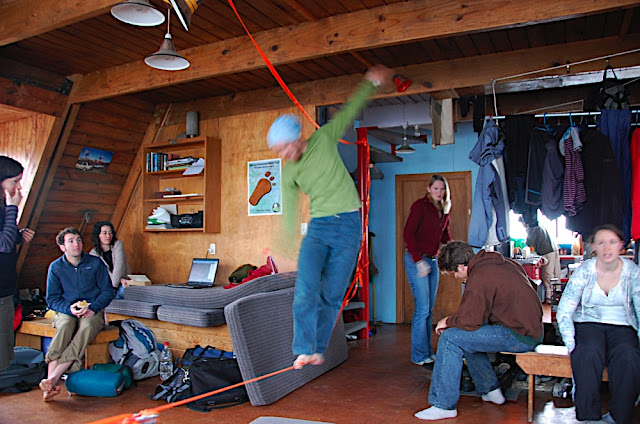
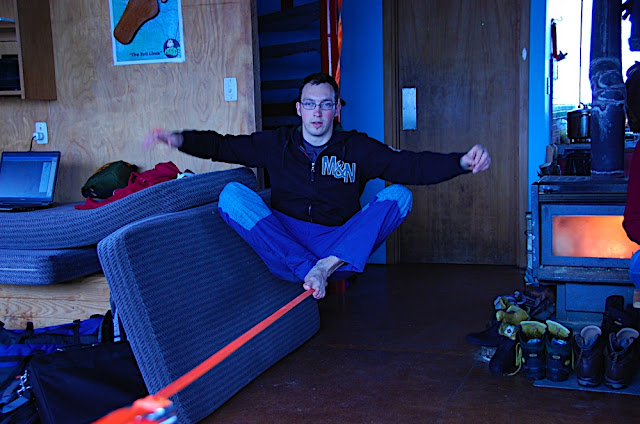
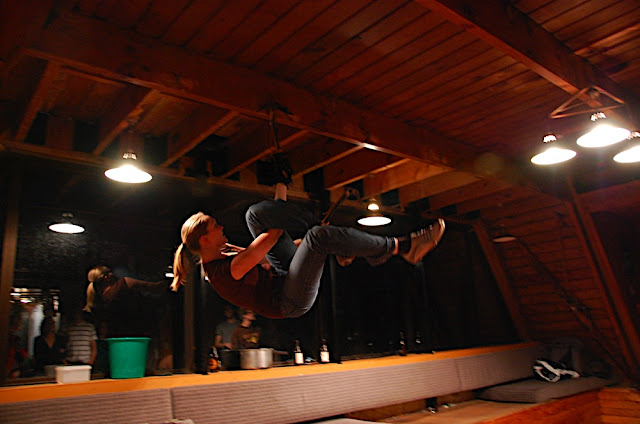


Here are a couple more pictures:
Here are a couple more pictures:
 |
| 08-07 Romaric's Birthday Party |
GLADE08
Here are a couple of photos from GLADE08, a two week conference/workshop in Auckland celebrating the 75th birthday of John Butcher.

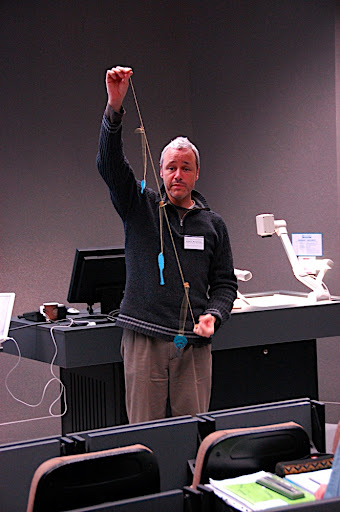


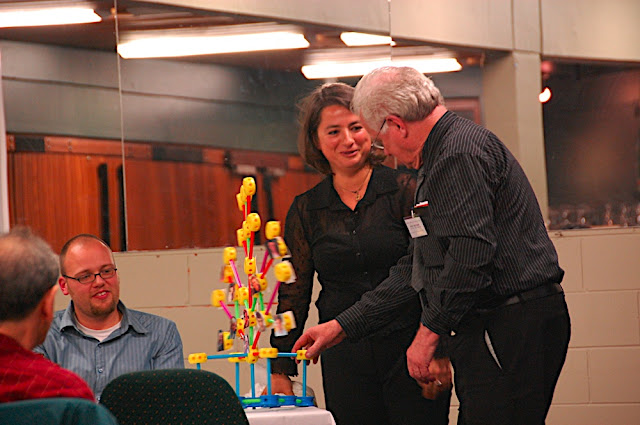
There are a couple more photos o'er at my Picasa pages too:
There are a couple more photos o'er at my Picasa pages too:
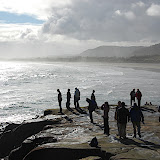 |
| 08-07 GLADE08 |
15 July, 2008
Parnell
The French market run by La Cigal (bottom part of St George's Bay Road in Parnell) has gotten even better since I was last there. More stalls and now excellent imported cheeses and a bakery based at the store who make excellent croissants. The market runs every Saturday morning. It's worth visiting if you happen to be near Auckland then. I think the bakery and cheese are there the rest of the time too and they're worth a visit in their own right. I'm enjoying some Tomme de Brebis at the moment. It might be $130 per kilo (the most Ive paid for cheese so far) but it tastes every cent of it.

 |
| 08-07 Parnell |
More on bikes on trains
An update of the bikes-on-trains discussions N and I have been having with Brian Baxter at Greater Wellington Regional Council. Cycle Advocacy Wellington have been watching the messages go back and forth and invited N and I to a meeting attend a meeting of the GWRC this week. The meeting is specifically about provisions for cycles in Wellington --- curious that Brian Baxter hasn't mentioned the meeting. I wonder: did it just slip his mind or does he not really want the consultation and feedback that he talks to us about?
Anyway, here are the last couple of messages, first the ones with N, then the ones with me:
Brian's fourth reply to N:
Date: 2008/7/10
From: Brian Baxter Brian.Baxter@gw.govt.nz
To: N
Hi,
We will certainly get feedback from train staff - they (their union) are very closely monitoring what is happening. The feedback will come via the union rather than from individuals.
We are serious about integrating cycling with public transport, but there is no getting away from the fact that cycle carriage on trains is hit or miss. As it would be on a bus that only has a rack for 2 bikes. Carriage will always be limited given available space (as it is also for people - there is only so much space available). That said, we are trialling the current arrangements, and we will look at other
possibilities, including retro-fitting the carriages, at the end of the trial.
Brian
N's fifth reply to Brian:
From: N
Date: 11 July 2008 11:42:59 AM
To: Brian.Baxter@gw.govt.nz
Hi Brian,
This will be my last email for a while - I am off to Korea for a couple of weeks for work - but I will have to try to jump on a train while I am there and see what provision they make for cyclists ;) I understand that there is always finite space on trains, whether for people or bikes. However, I was in Germany for about 3 years, and
while the space on a bus or a tram makes it unrealistic for a large group of cyclists to get on, it was really common to see a dozen bikes in a single carriage on commuter train services. And on weekends, a family of five would have no trouble in using the train to get out of the city centre for a biking trip. I am not suggesting that we can
model our transport system overall on what the Germans have, but our medium sized cities are about the same size as most of theirs, and rely on a similar mix of trains, buses, and trams (ok, the last is still on our wish list here). Bikes stack up quite well, and cyclists are usually pretty cooperative in terms of making space for others.
The biggest problem with the current system is that the onus is on the staff rather than the cyclists to make space for bikes - which has the result that staff feedback has been negative. I have personally had a lot of comments from Tranz Metro staff on my folding bike, telling me how much easier it would be for them if all cyclists could get on and off just like any other passenger. And they usually go on to make
comments about the price of petrol and how much sense it makes to combine cycling with the train - so the staff themselves are certainly aware of the issues!
I will be thrilled if you can bring up the idea of retro-fitting the carriages at the end of the trial - I think we can all agree that the results are likely to be disappointing in terms of the number of cyclists on trains, given the unanticipated cut to the number of cyclists.
Cheers,
Brian's first reply to me:
Dion
Thanks for your comments.
I have to say that GW is not the bad guy we are being painted as. We simply tried to do something right (by removing the cycle charge). Tranz Metro (in particular their staff) then decided to impose some limitation of their own based on what are perceived to be health and safety issues. We have been disappointed with the outcome, although I think the jury is still out with regard to the final effect. It has only been 10 days since the changes were made, and it seems from the feedback I am getting that Tranz Metro staff are still coming to grips with the detail (e.g. how many bikes can be carried per train) of the new policy.
I must also question your maths; it would have been extremely rare that 5 cycles could ever have been fitted into a baggage compartment. [That's not maths Brian. That's counting. Alas, maths has a bit more to it.]
Your suggestion of a permit system is interesting but I foresee a number of problems with it. But that can be added to the feedback which will all be considered when the current system is reviewed.
Brian
My first reply to Brian:
From: Me
Date: 10 July 2008 10:51:36 PM
To: Brian.Baxter@gw.govt.nz
Hi Brian,
Thanks for your reply. I really appreciate your willingness to discuss this matter. I appreciate also the intention of GWC to try and improve sustainable transport though the free bikes on trains policy.
Even though the free bikes on trains policy has only been in action for 10 days, observation suggests that the damage was in fact done some weeks before this policy took effect when, at least some, TranzMetro staff began implementing the two bikes per baggage compartment policy. By the time the free bikes on trains policy came into effect at the beginning of July the number of cyclists using the trains for commuting had already been decimated.
I feel it's most unfortunate that the free bikes on trains policy has had an effect opposite to that intended. It seems that TranzMetro and their staff have some role to play in this and perhaps my feedback and comments are best directed at them. TranzMetro haven't yet replied to the original letter you received from Nicola Gaston via Ping and so, since you are willing to address the issue, and perhaps take some action on it, I hope you don't mind if I continue to send my feedback to you.
While on this point, I'm not clear on what the exact line of responsibility and of governance is with TranzMetro. If you could clear this up I'd certainly appreciate it.
From the discussions with you so far I'm starting to get the impression that there are different perceptions about the number of bikes which have been and can be carried on trains. The figure of five bikes per baggage compartment which I used is from direct observation. They do indeed fit into one baggage compartment, though certainly not with ease. If GWC or TranzMetro have any more accurate information on the number of bikes carried per baggage compartment during peak travel times, such as a survey, then I would be interested to see it and would be happy to re-work the calculations I sent earlier. In the absence of such figures, I have to work with the numbers reported by the cyclists who, until recently, put their bikes in the said baggage compartments.
Another observation from the platform is that though most trains are made up of more than one par of carriages, and hence have more than one baggage compartment, I'm unaware of more than one baggage compartment ever being used. I suppose this is since the train conductor was required to unlock the baggage compartment at stops where bikes got on or off. Presumably the conductors felt it wouldn't be possible to do this with more than one compartment. The reality was, as far as I'm aware, only one baggage compartment per train ever operated. If this changed, and all the baggage compartments were used then the numbers of bikes carried on trains could be increased without any changes to trains or introducing complicated permit systems. I quite agree with you that my suggested permit system has problems. It also only offers a small improvement from the current situation, but none-the-less an improvement and improvement one way or another is really necessary in this situation.
Can I ask you at what date the current system will be reviewed and the form this review will take? Cycling and sustainable transport is something I feel strongly about and I would be disappointed to miss any scheduled public/user consultation on account of being unaware of the relevant dates and information.
With best regards,
09 July, 2008
A missive concerning bikes on trains, or the lack there of.
After a series of apparent anti-bike incidents on the train between Wellington and Petone (detailed below) N decided enough was enough. Below is the letter she sent to the Wellington councils. One person from the councils (Brian Baxter (brian.baxter@gw.govt.nz) the "Public Transport Design and Development manager" at the Greater Wellington Regional Council (GWC)) even bothered to reply and N has been sending a couple of letters back and forth with him. I'll put these underneath her initial letter. Though well intentioned it seems, from his replies, that Mr Baxter has missed some of the points of N's letter (can you find his reply to the ridiculous policy on folding bikes?) and wasn't really interested in improving the lot of cyclists on trains (or otherwise) in Wellington so I thought I add my voice to the discussion. My letter's at the bottom. I'd encourage more people to write to Mr Baxter and ask for something to be done about transport policy to make it easier and safer for people to use a bike going to and from work in the Wellington Region. If you don't say something, who else will?
N's Letter to the Wellington Councils:
Councillor Andy Foster (Urban Development & Transport)
andy.foster@wcc.govt.nz
Wellington City Council
and
Ping Sim (Sustainable Transport Planner)
ping.sim@gw.govt.nz
Greater Wellington Regional Council
CC: Cycling Advocates Network Wellington
CC: Tranz Metro
1 July 2008
Dear Wellington Council(s) Representatives,
I am writing to express my dismay at recent developments relating to the ability of Wellingtonians to commute by bicycle between Wellington City and Lower Hutt. I am not referring to the well-publicised deaths of two cyclists hit by trucks on the 19th of June, last week, tragic as they were. Instead I am writing to point out that despite recent efforts to increase the number of cyclists on trains, the number of cyclists has actually decreased drastically over the last month.
A little bit about me:
As a moderately safety conscious person who has had a number of close calls while riding my bicycle on New Zealand roads, I have since January been choosing to ride my bicycle to the railway station and take the train to Woburn station from where I have an additional 5 minute bike ride to work. Being able to take my bicycle on the train turns two 20-30 minute walks into 5 minutes each, and this turns a commute by public transport from a minimum of 90 minutes into a regular 40 minutes, which I even find pleasurable. I should mention that I do own a car and even drive to work once a week or fortnight, depending on weather and other committments. I choose to bike and take the train not because of cost (by my calculations the train ticket is still 10-20% more expensive than the cost of fuel for the same trip), not because of traffic (I commute in the opposite direction to the crowds, and I have the benefit of convenient free parking at work) but because I find it a reasonable and enjoyable alternative.
Bikes on trains survey:
A few months ago, I replied to a survey about bikes on trains in which I was pleased to be able to express the many strong opinions I had formed since moving to Wellington. I grew up in Auckland, where despite living on a hill, I always had a bike and for several years my brother, sister and I would come home from school and jump on our bicycles to deliver the evening paper. I have lived in Japan, where I used to cycle to school in ridiculous school uniform (short, pleated skirts!) holding an umbrella over my head on rainy days; I have biked about Beijing where I was comfortingly told by a local that if a car driver hit a cyclist he would be shot, so it was really very safe despite appearances; I have cycled along gorgeous cycleways in the British countryside, and along routes des Vins in France; and I have lived in Germany where bikes may be taken on trains, trams and buses, sometimes for a nominal fare and usually for free with any sort of weekly or monthly ticket. Bike to the shops; take the bus home when you have loaded up with too much shopping to manage on the bike.
And my experience since moving to Wellington? Well, there have been both positive and negative points.
Negatives:
Positives:
Despite the survey not really offering enough space for all this information, I happily ticked the boxes to say that I felt that the high cost (single adult fare) to take a bike on the train was a barrier to use of the service, and that free bikes would be a good thing (despite the fact that as an owner of a folding bike I was not personally affected by this point at the time). I now heartily regret my response.
The current problem: no space on trains
Somewhere around two months ago, a small article appeared in the Dominion Post to advise that as a result of the survey, bikes will be carried free on Tranz Metro trains from the 1st of July. Naturally enough, this was received with some pleasure by both myself and other cyclists who take the train. However, the next day, I had a brief conversation with one of the courteous and friendly Tranz Metro staff who frequent Wellington Station. After commenting on my folding bicycle, he asked whether I had heard the news. I replied yes, and that I was still pleased to have the folding bike because of the competition for space that would result from a free bikes policy. Typically at the time on the 8:05 Upper Hutt service, there were 4 commuters who would squeeze their bikes into the small space available. On some occasions there were five. He informed me that there had been a meeting at which it had been decided that a maximum of two bikes per train would be allowed. He then went on to say that even in the new units that have been ordered, no additional provision for bicycles has been made. I replied that I found this ridiculous, and went on to work where I recounted the conversation to the other cyclists I know who take the train.
Only 2 (two) bikes per train
It was only a few days later that we discovered the truth of this conversation. Waiting for the 5:37 pm service from Woburn station, 4 other cyclists and myself spent a cold hour waiting (this is unusual, but there had been an accident). When the train arrived I happily got on board and placed my folded bicycle under a seat, as usual. The other cyclists with me were summarily refused a place on the train as there were already two bikes on board, though passengers only occupied a quarter of the available seats. After a wait of over an hour, this seemed particularly harsh. Particularly when 4-5 bikes per train was a frequent occurrence only weeks before. Particularly when three of those cyclists were used to cycling, and catching the train, together.
That event occurred about a month ago. Since then, the only cyclist at my work who regularly catches the train is able to wait for the off-peak 9:05 service. The 4 cyclists who used to regularly catch the 8:05 service with their bikes have given up completely.
Further resistance to bikes on trains?
This week, I was told by a staff member on the train that a decision had been made that folding bikes would not be allowed to be carried in carriages, but would need to be placed in the special compartment. When I enquired as to why such a decision had been made, given that a folding bike fits in the gap between two seats that face in opposite directions, and therefore takes up no useable space on the train, I was told that it was because such bikes will become “projectiles in the event of an accident”. I will repeat that my bicycle goes under/between 2 seats and is wholly immobilised while it is there. I have a bag in which I can put my bicycle once it is folded up – it makes it a perfect piece of hand luggage, smaller (and lighter!) than many suitcases. I am certainly able to start bringing my bag with me to the train station if it becomes necessary (I should mention that the staff member I spoke to even suggested this) – but I really object to the need to comply with senseless rules, especially when they have an effect completely counter to the current imperative, which should be to make it easier to use public transport for commuting.
The problem: point of view of the Tranz Metro staff?
My overall impression based on my dealings with Tranz Metro staff over the last 6 months is that there is a very small base of strong anti-cyclist sentiment amongst the staff. My best guess is that this is related to the extra effort required of them for cyclists. I do understand that the current system for carriage of bikes is antiquated and awkward, conductors are required to unlock the door to the front compartment where the bikes are stored, which requires of them the additional effort of enquiring of each bike-carrying passenger at which stop they plan to get off. It is simple enough to understand, given the current system, why some Tranz Metro staff are noticeably averse to bikes and their owners!
A solution
In the bikes on trains survey, I added in the optional comments section that I felt that space for bikes on trains was also an issue, and I went as far as offering a suggestion for quick and inexpensive conversion of the existing carriages for the transport of bicycles, based on what I have seen on trams, trains, and even buses overseas. At the end of the carriage where a seat has been modified to fold up to allow a wheelchair to be rolled into the resulting space, one should convert the entire bench to such folding seats, supply a hook and strap on the underside of the seats and a clip such that when they are folded up a bicycle may be leant again them and secured with the strap. Simple, cheap to do, and safe. Moreover, the fact that passengers will be able to load, secure, and off load their bicycles themselves will solve the issue with respect to the additional effort required of staff.
Additional wish list
It is very difficult to understand, given the layout of Wellington and patterns of commuting, why there is not a decent bike path from the Hutt Valley into Wellington around the waterfront. By decent, I mean something that has been designed and constructed with cyclists in mind. A three metre wide, properly surfaced, 2-lane route on the harbour-side of the railway tracks would fit the bill – the only obstacle I can see is the ferry terminal coming in to the city, where the path would have to shift in to meet the roads. One would have to signpost it properly to ensure that any pedestrians knew that cyclists have right-of-way – and I would suggest a coloured surface, not only for this but for all cycle paths in the city – cyclists need spaces, but motorists and pedestrians need to be able to see and recognise them!
Conclusion: what can you do?
In conclusion, the purpose of this letter is to inform you that based on my experience and observation there will be no more bikes in trains from the 1st of July, and there will almost certainly be considerably fewer than at this time last year. And on the roads? Cyclists will keep being killed on our roads unless roads are designed to be safe for them. Wellington could be improved hugely with relatively little effort – in the CBD, well marked and connected bike lanes would make a huge difference, in contrast to the currently unused bike lane that someone saw fit to construct in isolation alongside the city bypass. In the absence of light rail to connect trains to the south of the city, cycling is one of the best options we have – but at the moment it is dangerous. The answer is not, in my humble opinion, just to make individual cyclists visible: it is to make cycling itself visible, as a permanent feature of the design of our roads and city spaces. There are solutions to all problems, and I am not the sort of person to write a letter of complaint without suggesting at least a few plausible steps that could be taken. I am quite sure that if Tranz Metro would consent to my suggestion to permit bikes within carriages, we could come up with donations and volunteer labour for the progressive conversion of the current seats. Silly as it seems, such a conversion could also be applied to the new trains once they arrive.
If only all problems could be solved as simply!
Yours, very sincerely,
The first reply:
From: Brian Baxter Brian.Baxter@gw.govt.nz
Sent: Wednesday, 2 July 2008
Your letter addressed to Ping Sim has been passed on to me by Ping.
It has been a somewhat unfortunate result of the removal of the
carriage charge that the number of cycles carried on the train has
been restricted by Tranz Metro (not to 2 cycles per train, but to 2
cycles per 2-car set, which depending on how may 2 car sets make up
the trains, usually means 4 cycles can be carried (2 in each baggage
compartment)).
The restrictions were introduced after a safety audit conducted by
Tranz Metro (sparked by the decision to remove the charge, and the
subsequent concern by Tranz Metro staff that they would be swamped by
cyclists).
Contrary to what you have been told, the new trains (on order, and
currently undergoing final design) will have provision for cycles
(along the lines of your suggestion). There will be no separate
compartment, but there will be a "multi-functional" area within each
carriage which will have space for wheelchairs, cycles, and large
items. The actual design of this area is still being finalised.
You may have noticed the new posters, brochures etc produced by Tranz
Metro this week. It is an attempt to standardise what has been a
fairly informal system of bike carriage, and remove some of the staff
discretion that exists at the moment. Hopefully the outcome will be
positive.
Brian
Brian Baxter
Manager Design and Development
Public Transport Division
Greater Wellington Regional Council
DD 04 802 0302
027 211 0359
brian.baxter@gw.govt.nz
N's first response:
From: N
Sent: Tuesday, 8 July 2008
To: Brian Baxter Brian.Baxter@gw.govt.nz
Subject: Re: Cycles on Trains
Hi Brian,
Thanks for your reply - I have been out of town for a few days so am
just catching up on this.
I am relieved to hear that there has been some common sense in designing
the new trains for the carriage of bikes. I actually have not seen the
new posters/brochures and can not see any new information on the Tranz
Metro site, so am not sure what you are referring to.
Given that my feedback from Tranz Metro staff has been particularly
negative with respect to progress with bikes on trains (they have
certainly been enforcing 2 bikes per train, not per baggage
compartment), and even the carriage of folding bikes is being actively
discouraged, I am afraid that I do not share your optimism that all will
be well when the new trains arrive. I am not sure what the date is
supposed to be - is it 2009 sometime?
My final concern is that an initiative to promote cyclists on trains has
seriously backfired, resulting in a seriously inferior result for many
commuters. This cannot be considered to be a success by you, surely?
I think you would gain a lot of support and credibility if you were to
put out a press release acknowledging that not enough bicycles can
currently be carried on the trains, and announcing steps to improve the
situation. I am not sure why a cheap retrofit of the current units
cannot be considered? Especially given that the new trains are still
some way away and current use of the train service really would seem to
justify immediate steps to improve the service.
Two bicycles per train would be fine if it were only a five minute wait
for the next train. With typically a 30 minute service at peak times, 2
bikes per train is a joke for regular, serious commuters.
Is there any way that you could see to take steps towards more immediate
improvements?
Cheers,
N
The second reply:
From: Brian Baxter Brian.Baxter@gw.govt.nz
Sent: Wednesday, 9 July 2008
Hi,
Thanks for your comments. The info (including a copy of the Tranz Metro
brochure), is on the Tranz Metro website (under general
information/bicycles). Their brochure makes it clear that it is 2 bikes
per baggage compartment, and not 2 bikes per train.
The new trains are due to arrive in late 2010.
I agree that the initiative was not as successful as we had hoped. But
at least cycle carriage is free, and that will benefit many users. The
current situation has been introduced on a trial basis, and things may
subsequently change as a result of what is happening.
Brian
N's second response:
From: N
To: Brian Baxter Brian.Baxter@gw.govt.nz
Subject: Re: Cycles on Trains
Date: Wednesday, 9 July 2008
Hi Brian,
Thanks for the reply - especially for directing me to the brochure on
the website. I spent a lot of time looking for information about the
carriage of bikes when I first moved to Wellington, so I guess I am
pleased to see something there now.
Does it make any sense to be talking about a "trial period" when you
already know that there are less bikes being carried than there were a
year ago - at least on peak (commuter) services, if not overall?
Commuters actually need some certainty about being able to get on the
train. Hasn't this just been set up for failure? According to what
criteria is this "trial" going to be evaluated? It certainly seems
hard for me to share your optimism at this stage.
Cheers,
N
The third reply:
To: N
From: Brian Baxter Brian.Baxter@gw.govt.nz
Subject: Re: Cycles on Trains
Date: Wednesday, 9 July 2008
Hi Nicola
Bike carriage on trains has always been a bit "hit or miss", with
limited space always being an issue, as has the response of the train
guards. There never has been, or will be, certainty that carriage will
occur. This is not just an issue for Wellington, but is common all
round the world (where in fact it is usual for bikes to not be carried
at peak times).
We have no criteria for the trial; we will just wait and see what
happens, and rely on feedback such as yours to assist us in deciding
what happens. The experiences of Tranz Metro and its staff will also
paly a role in determining what happens in the future.
Brian
Oh great, so it turn out that GWC are using a "trial" with no criteria or planning in order to see if they can reach their goal of running a transport system that is at best "a bit hit-and-miss"! Sheeesh!
N's third response:
From: N
To: Brian Baxter Brian.Baxter@gw.govt.nz
Subject: Re: Cycles on Trains
Date: Wednesday, 9 July 2008
Hi Brian,
I really appreciate your responsiveness, so I hope you don't feel that
I am badgering you. But since you say that feedback is your main
criteria for evaluating this trial, I just want to make one or two
further comments.
I don't know how you go about getting feedback from the train staff.
I believe that a personal survey of them, asking about their
experiences with bikes, and asking them to comment on my suggestion of
retrofitting the carriages to allow safe transport of bikes within
carriages, would probably result in different opinions than simply
inviting staff to comment on the current situation, which as I pointed
out in my letter is really unsatisfactory for both cyclists and staff.
Secondly - is it really satisfactory to say that carriage of bikes has
always been hit and miss, and is so in some places overseas, and
therefore (presumably) always will be hit and miss? I was under the
impression that the council wanted to encourage both cycling and the
use of public transport, and if so then surely the council should be
receptive to my idea of a cheap retrofit of the current carriage to
enable the initiative of free bikes on trains to actually mean
something.
Lastly - you haven't really commented on my idea of retrofitting the
current carriages. If the new trains are not due till 2010, then
surely it is worth trying to do something now (i.e. before the end of
the year)? I would be interested to know what you think the barriers
to implementation of this idea would be, and whether there is any
chance of something like this happening. I am not asking for promises
- but are you in a position to take this idea any further?
Cheers again,
N
And my letter to Mr Baxter:
From: Me
To: Brian Baxter Brian.Baxter@gw.govt.nz
Subject: Re: Cycles on Trains
Date: Wednesday, 9 July 2008
Hi Brian,
I'm another commuter who uses a bike for daily travel to and from work and who has been disappointed to see the reduction of both, access to, and real numbers of, bikes on trains in Wellington. As such I'd like to add my voice to this discussion.
I'd like to present two scenarios of carriage of bikes on trains with calculations based on some very rough numbers. I'll present the scenarios per baggage compartment rather than per train. If you feel that most trains have two baggage compartments, double all the totals.
Scenario one:
Prior to the current policy of limiting two bikes per baggage compartment commuter trains allowed carriage of five or six bikes per baggage compartment. Let's say peak commuter time was trains departing from 7:30 to 8:30 am, three trains per morning for any particular line at the average scheduled departure rate. Since the cost of taking a bike on the train was rather high it was feasible to rely on making a bike/train commute between and Lower Hutt. It was uncommon that one was refused carriage of ones bike so at least 15 people per line, per morning could rely (I want to stress that word) on being able to get to work in this fashion during peak times. With return journeys and five work days per week that makes 150 successful cycle/train commutes per line per week at least. I've tried to use the lowest numbers possible here to make my point as convincing as possible.
Scenario two:
New Tranzmetro policy is to allow a maximum of two bikes per baggage compartment. The five cyclists who were previously able to be confident of getting on the train with their bike at 7:30 now find that only two of them will be let on. Let's say it's chance which two of the five get on the train. The probability of them being able to catch their original train to work is two out of five. That is, there is a 60% chance that each morning they won't get to work at the time they planned. This seems pretty bad. As a comparison, think of owning a car that only starts two days out of five. I doubt you would try to take it to work. That was the first train of the morning. We'll assume that those five cyclists are infinitely patient and optimistic. Despite the fact that they have to wait half an hour in the cold, the three who were refused carriage of their bikes on the 7:30 train wait around until the 8:00 train. Along with the five other cyclists who caught that train under the previous policy. Now the chances of any one of the cyclists getting on the 8:00 train are two in eight. 75% of the cyclists get left behind. I can't think of any other service that fails 75% of the time, oh, except for the 8:30 train where, if we continue our scenario, there are now six cyclists waiting who couldn't get on the previous train and five who normally catch the 8:30. Two get on it, nine get left behind. The 8:30 train fails 82% of the cyclists waiting for it, some of whom could have been waiting since 7:30. These people cycle back home and drive to work --- for most of them it's cheaper and faster than the train is anyway, even with petrol at $2.19/L. This is for a train traveling north which is only about 25% full of passengers anyway.
Can I ask you, if you were one of the cyclists in scenario two, how many days would you keep trying to get on the train before giving up even going to the station with your bike? A week of getting to work late and waiting hours for a train before you start driving to work?
One week later all of the cyclists who experienced scenario two have stopped going to the train station with their bikes. Sure the train could carry two of them to and from work (20 return journeys per week). But the odds of you being one of those two people on the train are so low. Who is going to be silly enough to ignore the fact that the chance of the getting to work on time is never better than 40%. As a consequence, the sudden reduction of the number of bikes carried per train has resulted in utterly no one using a train/cycle combination to get to work. At least that is what has been observed. If you wish, say one new person tries to get their bike on the train, succeeds and gives you 10 return journeys per line/per week. This is a reduction from the previous 150 return journeys that occurred in scenario one --- all as a direct and immediate result of Tranzmetro/GWC policy.
Can I ask you whether you can see anything positive about this situation? If this is the way things are to continue for the next two years until late 2010 then you will have prevented something in the order of 11,000 cycle/train commutes per train line. If you think that most trains have two baggage compartments, then double that number.
I ask, is this a piece of policy the GWC is proud of?
Though I wonder at the reasoning which lead to a 60% reduction in the number of bikes allowed on trains (from five down to two per baggage compartment) and how this was seen to be helping cyclists or sustainable transport, I have faith that the GWC policy change concerning bikes on trains was well intentioned and not designed to all but eliminate the carriage of bikes on trains. I therefore offer a suggestion which, although I see it as being far from desirable, would, none-the-less, be a marked improvement on the current situation.
A big deterrent to taking a bike on the train now is the low likelihood of your bike being carried --- a consequence of the low numbers of bikes carried per train. If Tranzmetro were to issue a fixed number of "permits" per train that assured people their bike would be carried on a particular line at a particular time then that small number of people could be confident of getting to work on time. People without a permit could have their bike carried if space remained. Clearly this solution does not fix the overall problem since it only allows a very small number of people any certainty. I believe, however, that the current situation is so bad that if even two people were able to cycle commute per train (or baggage compartment) per line then this would be an improvement on the current lottery which has deterred nearly all cyclists from including a train journey in their morning commute.
I estimate that such a system would create an extra 1600 cycle/train commutes per baggage compartment in the two years between now and the arrival of the new trains in 2010. Though this is a far cry from the estimated 11,000 commutes which current policy has eliminated, it is, a small step in the right direction. Of course, I welcome bigger policy changes than this from GWC allowing even more commutes but in the absence of that, I hope this small improvement is possible.
I look forward to your answers to my questions above and to your opinion on possible improvements in the next two years until any new carriages arrive.
With best regards, and in intense frustration,
N's Letter to the Wellington Councils:
Councillor Andy Foster (Urban Development & Transport)
andy.foster@wcc.govt.nz
Wellington City Council
and
Ping Sim (Sustainable Transport Planner)
ping.sim@gw.govt.nz
Greater Wellington Regional Council
CC: Cycling Advocates Network Wellington
CC: Tranz Metro
1 July 2008
Dear Wellington Council(s) Representatives,
I am writing to express my dismay at recent developments relating to the ability of Wellingtonians to commute by bicycle between Wellington City and Lower Hutt. I am not referring to the well-publicised deaths of two cyclists hit by trucks on the 19th of June, last week, tragic as they were. Instead I am writing to point out that despite recent efforts to increase the number of cyclists on trains, the number of cyclists has actually decreased drastically over the last month.
A little bit about me:
As a moderately safety conscious person who has had a number of close calls while riding my bicycle on New Zealand roads, I have since January been choosing to ride my bicycle to the railway station and take the train to Woburn station from where I have an additional 5 minute bike ride to work. Being able to take my bicycle on the train turns two 20-30 minute walks into 5 minutes each, and this turns a commute by public transport from a minimum of 90 minutes into a regular 40 minutes, which I even find pleasurable. I should mention that I do own a car and even drive to work once a week or fortnight, depending on weather and other committments. I choose to bike and take the train not because of cost (by my calculations the train ticket is still 10-20% more expensive than the cost of fuel for the same trip), not because of traffic (I commute in the opposite direction to the crowds, and I have the benefit of convenient free parking at work) but because I find it a reasonable and enjoyable alternative.
Bikes on trains survey:
A few months ago, I replied to a survey about bikes on trains in which I was pleased to be able to express the many strong opinions I had formed since moving to Wellington. I grew up in Auckland, where despite living on a hill, I always had a bike and for several years my brother, sister and I would come home from school and jump on our bicycles to deliver the evening paper. I have lived in Japan, where I used to cycle to school in ridiculous school uniform (short, pleated skirts!) holding an umbrella over my head on rainy days; I have biked about Beijing where I was comfortingly told by a local that if a car driver hit a cyclist he would be shot, so it was really very safe despite appearances; I have cycled along gorgeous cycleways in the British countryside, and along routes des Vins in France; and I have lived in Germany where bikes may be taken on trains, trams and buses, sometimes for a nominal fare and usually for free with any sort of weekly or monthly ticket. Bike to the shops; take the bus home when you have loaded up with too much shopping to manage on the bike.
And my experience since moving to Wellington? Well, there have been both positive and negative points.
Negatives:
- No bike paths! I have tried the (supposed) bike path between the Hutt Valley and Wellington City – alongside SH2 the path is rough, covered in glass, and there are frequently pedestrians inside the barrier that require cyclists to stop – therefore most cylists stay on the outside of the barrier with the cars. After exiting SH2 the path continues along a footpath which is very poorly marked - even as a cyclist knowing that there was supposed to be a bike path the whole way along I was very unsure at times. I can't imagine how motorists are expected to see cyclists before turning!
- Full adult fares for bikes on trains (even in Auckland they only charge $1)
- Lack of advertising of the monthly bike ticket deal (see below)
- Two bikes per train policy (introduced the day after the announcement of free bikes on trains) – has resulted in many regular commuters leaving their bikes at home
- Staff help required to get a bike in/out of the special compartment
Positives:
- Monthly tickets for bikes at $5 surcharge
- Lovely, flat roads in the cbd and along the waterfront
- Free bikes on trains (from 1 July 2008)
- Generally pleasant and helpful staff on the trains
Despite the survey not really offering enough space for all this information, I happily ticked the boxes to say that I felt that the high cost (single adult fare) to take a bike on the train was a barrier to use of the service, and that free bikes would be a good thing (despite the fact that as an owner of a folding bike I was not personally affected by this point at the time). I now heartily regret my response.
The current problem: no space on trains
Somewhere around two months ago, a small article appeared in the Dominion Post to advise that as a result of the survey, bikes will be carried free on Tranz Metro trains from the 1st of July. Naturally enough, this was received with some pleasure by both myself and other cyclists who take the train. However, the next day, I had a brief conversation with one of the courteous and friendly Tranz Metro staff who frequent Wellington Station. After commenting on my folding bicycle, he asked whether I had heard the news. I replied yes, and that I was still pleased to have the folding bike because of the competition for space that would result from a free bikes policy. Typically at the time on the 8:05 Upper Hutt service, there were 4 commuters who would squeeze their bikes into the small space available. On some occasions there were five. He informed me that there had been a meeting at which it had been decided that a maximum of two bikes per train would be allowed. He then went on to say that even in the new units that have been ordered, no additional provision for bicycles has been made. I replied that I found this ridiculous, and went on to work where I recounted the conversation to the other cyclists I know who take the train.
Only 2 (two) bikes per train
It was only a few days later that we discovered the truth of this conversation. Waiting for the 5:37 pm service from Woburn station, 4 other cyclists and myself spent a cold hour waiting (this is unusual, but there had been an accident). When the train arrived I happily got on board and placed my folded bicycle under a seat, as usual. The other cyclists with me were summarily refused a place on the train as there were already two bikes on board, though passengers only occupied a quarter of the available seats. After a wait of over an hour, this seemed particularly harsh. Particularly when 4-5 bikes per train was a frequent occurrence only weeks before. Particularly when three of those cyclists were used to cycling, and catching the train, together.
That event occurred about a month ago. Since then, the only cyclist at my work who regularly catches the train is able to wait for the off-peak 9:05 service. The 4 cyclists who used to regularly catch the 8:05 service with their bikes have given up completely.
Further resistance to bikes on trains?
This week, I was told by a staff member on the train that a decision had been made that folding bikes would not be allowed to be carried in carriages, but would need to be placed in the special compartment. When I enquired as to why such a decision had been made, given that a folding bike fits in the gap between two seats that face in opposite directions, and therefore takes up no useable space on the train, I was told that it was because such bikes will become “projectiles in the event of an accident”. I will repeat that my bicycle goes under/between 2 seats and is wholly immobilised while it is there. I have a bag in which I can put my bicycle once it is folded up – it makes it a perfect piece of hand luggage, smaller (and lighter!) than many suitcases. I am certainly able to start bringing my bag with me to the train station if it becomes necessary (I should mention that the staff member I spoke to even suggested this) – but I really object to the need to comply with senseless rules, especially when they have an effect completely counter to the current imperative, which should be to make it easier to use public transport for commuting.
The problem: point of view of the Tranz Metro staff?
My overall impression based on my dealings with Tranz Metro staff over the last 6 months is that there is a very small base of strong anti-cyclist sentiment amongst the staff. My best guess is that this is related to the extra effort required of them for cyclists. I do understand that the current system for carriage of bikes is antiquated and awkward, conductors are required to unlock the door to the front compartment where the bikes are stored, which requires of them the additional effort of enquiring of each bike-carrying passenger at which stop they plan to get off. It is simple enough to understand, given the current system, why some Tranz Metro staff are noticeably averse to bikes and their owners!
A solution
In the bikes on trains survey, I added in the optional comments section that I felt that space for bikes on trains was also an issue, and I went as far as offering a suggestion for quick and inexpensive conversion of the existing carriages for the transport of bicycles, based on what I have seen on trams, trains, and even buses overseas. At the end of the carriage where a seat has been modified to fold up to allow a wheelchair to be rolled into the resulting space, one should convert the entire bench to such folding seats, supply a hook and strap on the underside of the seats and a clip such that when they are folded up a bicycle may be leant again them and secured with the strap. Simple, cheap to do, and safe. Moreover, the fact that passengers will be able to load, secure, and off load their bicycles themselves will solve the issue with respect to the additional effort required of staff.
Additional wish list
It is very difficult to understand, given the layout of Wellington and patterns of commuting, why there is not a decent bike path from the Hutt Valley into Wellington around the waterfront. By decent, I mean something that has been designed and constructed with cyclists in mind. A three metre wide, properly surfaced, 2-lane route on the harbour-side of the railway tracks would fit the bill – the only obstacle I can see is the ferry terminal coming in to the city, where the path would have to shift in to meet the roads. One would have to signpost it properly to ensure that any pedestrians knew that cyclists have right-of-way – and I would suggest a coloured surface, not only for this but for all cycle paths in the city – cyclists need spaces, but motorists and pedestrians need to be able to see and recognise them!
Conclusion: what can you do?
In conclusion, the purpose of this letter is to inform you that based on my experience and observation there will be no more bikes in trains from the 1st of July, and there will almost certainly be considerably fewer than at this time last year. And on the roads? Cyclists will keep being killed on our roads unless roads are designed to be safe for them. Wellington could be improved hugely with relatively little effort – in the CBD, well marked and connected bike lanes would make a huge difference, in contrast to the currently unused bike lane that someone saw fit to construct in isolation alongside the city bypass. In the absence of light rail to connect trains to the south of the city, cycling is one of the best options we have – but at the moment it is dangerous. The answer is not, in my humble opinion, just to make individual cyclists visible: it is to make cycling itself visible, as a permanent feature of the design of our roads and city spaces. There are solutions to all problems, and I am not the sort of person to write a letter of complaint without suggesting at least a few plausible steps that could be taken. I am quite sure that if Tranz Metro would consent to my suggestion to permit bikes within carriages, we could come up with donations and volunteer labour for the progressive conversion of the current seats. Silly as it seems, such a conversion could also be applied to the new trains once they arrive.
If only all problems could be solved as simply!
Yours, very sincerely,
The first reply:
From: Brian Baxter Brian.Baxter@gw.govt.nz
Sent: Wednesday, 2 July 2008
Your letter addressed to Ping Sim has been passed on to me by Ping.
It has been a somewhat unfortunate result of the removal of the
carriage charge that the number of cycles carried on the train has
been restricted by Tranz Metro (not to 2 cycles per train, but to 2
cycles per 2-car set, which depending on how may 2 car sets make up
the trains, usually means 4 cycles can be carried (2 in each baggage
compartment)).
The restrictions were introduced after a safety audit conducted by
Tranz Metro (sparked by the decision to remove the charge, and the
subsequent concern by Tranz Metro staff that they would be swamped by
cyclists).
Contrary to what you have been told, the new trains (on order, and
currently undergoing final design) will have provision for cycles
(along the lines of your suggestion). There will be no separate
compartment, but there will be a "multi-functional" area within each
carriage which will have space for wheelchairs, cycles, and large
items. The actual design of this area is still being finalised.
You may have noticed the new posters, brochures etc produced by Tranz
Metro this week. It is an attempt to standardise what has been a
fairly informal system of bike carriage, and remove some of the staff
discretion that exists at the moment. Hopefully the outcome will be
positive.
Brian
Brian Baxter
Manager Design and Development
Public Transport Division
Greater Wellington Regional Council
DD 04 802 0302
027 211 0359
brian.baxter@gw.govt.nz
N's first response:
From: N
Sent: Tuesday, 8 July 2008
To: Brian Baxter Brian.Baxter@gw.govt.nz
Subject: Re: Cycles on Trains
Hi Brian,
Thanks for your reply - I have been out of town for a few days so am
just catching up on this.
I am relieved to hear that there has been some common sense in designing
the new trains for the carriage of bikes. I actually have not seen the
new posters/brochures and can not see any new information on the Tranz
Metro site, so am not sure what you are referring to.
Given that my feedback from Tranz Metro staff has been particularly
negative with respect to progress with bikes on trains (they have
certainly been enforcing 2 bikes per train, not per baggage
compartment), and even the carriage of folding bikes is being actively
discouraged, I am afraid that I do not share your optimism that all will
be well when the new trains arrive. I am not sure what the date is
supposed to be - is it 2009 sometime?
My final concern is that an initiative to promote cyclists on trains has
seriously backfired, resulting in a seriously inferior result for many
commuters. This cannot be considered to be a success by you, surely?
I think you would gain a lot of support and credibility if you were to
put out a press release acknowledging that not enough bicycles can
currently be carried on the trains, and announcing steps to improve the
situation. I am not sure why a cheap retrofit of the current units
cannot be considered? Especially given that the new trains are still
some way away and current use of the train service really would seem to
justify immediate steps to improve the service.
Two bicycles per train would be fine if it were only a five minute wait
for the next train. With typically a 30 minute service at peak times, 2
bikes per train is a joke for regular, serious commuters.
Is there any way that you could see to take steps towards more immediate
improvements?
Cheers,
N
The second reply:
From: Brian Baxter Brian.Baxter@gw.govt.nz
Sent: Wednesday, 9 July 2008
Hi,
Thanks for your comments. The info (including a copy of the Tranz Metro
brochure), is on the Tranz Metro website (under general
information/bicycles). Their brochure makes it clear that it is 2 bikes
per baggage compartment, and not 2 bikes per train.
The new trains are due to arrive in late 2010.
I agree that the initiative was not as successful as we had hoped. But
at least cycle carriage is free, and that will benefit many users. The
current situation has been introduced on a trial basis, and things may
subsequently change as a result of what is happening.
Brian
N's second response:
From: N
To: Brian Baxter Brian.Baxter@gw.govt.nz
Subject: Re: Cycles on Trains
Date: Wednesday, 9 July 2008
Hi Brian,
Thanks for the reply - especially for directing me to the brochure on
the website. I spent a lot of time looking for information about the
carriage of bikes when I first moved to Wellington, so I guess I am
pleased to see something there now.
Does it make any sense to be talking about a "trial period" when you
already know that there are less bikes being carried than there were a
year ago - at least on peak (commuter) services, if not overall?
Commuters actually need some certainty about being able to get on the
train. Hasn't this just been set up for failure? According to what
criteria is this "trial" going to be evaluated? It certainly seems
hard for me to share your optimism at this stage.
Cheers,
N
The third reply:
To: N
From: Brian Baxter Brian.Baxter@gw.govt.nz
Subject: Re: Cycles on Trains
Date: Wednesday, 9 July 2008
Hi Nicola
Bike carriage on trains has always been a bit "hit or miss", with
limited space always being an issue, as has the response of the train
guards. There never has been, or will be, certainty that carriage will
occur. This is not just an issue for Wellington, but is common all
round the world (where in fact it is usual for bikes to not be carried
at peak times).
We have no criteria for the trial; we will just wait and see what
happens, and rely on feedback such as yours to assist us in deciding
what happens. The experiences of Tranz Metro and its staff will also
paly a role in determining what happens in the future.
Brian
Oh great, so it turn out that GWC are using a "trial" with no criteria or planning in order to see if they can reach their goal of running a transport system that is at best "a bit hit-and-miss"! Sheeesh!
N's third response:
From: N
To: Brian Baxter Brian.Baxter@gw.govt.nz
Subject: Re: Cycles on Trains
Date: Wednesday, 9 July 2008
Hi Brian,
I really appreciate your responsiveness, so I hope you don't feel that
I am badgering you. But since you say that feedback is your main
criteria for evaluating this trial, I just want to make one or two
further comments.
I don't know how you go about getting feedback from the train staff.
I believe that a personal survey of them, asking about their
experiences with bikes, and asking them to comment on my suggestion of
retrofitting the carriages to allow safe transport of bikes within
carriages, would probably result in different opinions than simply
inviting staff to comment on the current situation, which as I pointed
out in my letter is really unsatisfactory for both cyclists and staff.
Secondly - is it really satisfactory to say that carriage of bikes has
always been hit and miss, and is so in some places overseas, and
therefore (presumably) always will be hit and miss? I was under the
impression that the council wanted to encourage both cycling and the
use of public transport, and if so then surely the council should be
receptive to my idea of a cheap retrofit of the current carriage to
enable the initiative of free bikes on trains to actually mean
something.
Lastly - you haven't really commented on my idea of retrofitting the
current carriages. If the new trains are not due till 2010, then
surely it is worth trying to do something now (i.e. before the end of
the year)? I would be interested to know what you think the barriers
to implementation of this idea would be, and whether there is any
chance of something like this happening. I am not asking for promises
- but are you in a position to take this idea any further?
Cheers again,
N
And my letter to Mr Baxter:
From: Me
To: Brian Baxter Brian.Baxter@gw.govt.nz
Subject: Re: Cycles on Trains
Date: Wednesday, 9 July 2008
Hi Brian,
I'm another commuter who uses a bike for daily travel to and from work and who has been disappointed to see the reduction of both, access to, and real numbers of, bikes on trains in Wellington. As such I'd like to add my voice to this discussion.
I'd like to present two scenarios of carriage of bikes on trains with calculations based on some very rough numbers. I'll present the scenarios per baggage compartment rather than per train. If you feel that most trains have two baggage compartments, double all the totals.
Scenario one:
Prior to the current policy of limiting two bikes per baggage compartment commuter trains allowed carriage of five or six bikes per baggage compartment. Let's say peak commuter time was trains departing from 7:30 to 8:30 am, three trains per morning for any particular line at the average scheduled departure rate. Since the cost of taking a bike on the train was rather high it was feasible to rely on making a bike/train commute between and Lower Hutt. It was uncommon that one was refused carriage of ones bike so at least 15 people per line, per morning could rely (I want to stress that word) on being able to get to work in this fashion during peak times. With return journeys and five work days per week that makes 150 successful cycle/train commutes per line per week at least. I've tried to use the lowest numbers possible here to make my point as convincing as possible.
Scenario two:
New Tranzmetro policy is to allow a maximum of two bikes per baggage compartment. The five cyclists who were previously able to be confident of getting on the train with their bike at 7:30 now find that only two of them will be let on. Let's say it's chance which two of the five get on the train. The probability of them being able to catch their original train to work is two out of five. That is, there is a 60% chance that each morning they won't get to work at the time they planned. This seems pretty bad. As a comparison, think of owning a car that only starts two days out of five. I doubt you would try to take it to work. That was the first train of the morning. We'll assume that those five cyclists are infinitely patient and optimistic. Despite the fact that they have to wait half an hour in the cold, the three who were refused carriage of their bikes on the 7:30 train wait around until the 8:00 train. Along with the five other cyclists who caught that train under the previous policy. Now the chances of any one of the cyclists getting on the 8:00 train are two in eight. 75% of the cyclists get left behind. I can't think of any other service that fails 75% of the time, oh, except for the 8:30 train where, if we continue our scenario, there are now six cyclists waiting who couldn't get on the previous train and five who normally catch the 8:30. Two get on it, nine get left behind. The 8:30 train fails 82% of the cyclists waiting for it, some of whom could have been waiting since 7:30. These people cycle back home and drive to work --- for most of them it's cheaper and faster than the train is anyway, even with petrol at $2.19/L. This is for a train traveling north which is only about 25% full of passengers anyway.
Can I ask you, if you were one of the cyclists in scenario two, how many days would you keep trying to get on the train before giving up even going to the station with your bike? A week of getting to work late and waiting hours for a train before you start driving to work?
One week later all of the cyclists who experienced scenario two have stopped going to the train station with their bikes. Sure the train could carry two of them to and from work (20 return journeys per week). But the odds of you being one of those two people on the train are so low. Who is going to be silly enough to ignore the fact that the chance of the getting to work on time is never better than 40%. As a consequence, the sudden reduction of the number of bikes carried per train has resulted in utterly no one using a train/cycle combination to get to work. At least that is what has been observed. If you wish, say one new person tries to get their bike on the train, succeeds and gives you 10 return journeys per line/per week. This is a reduction from the previous 150 return journeys that occurred in scenario one --- all as a direct and immediate result of Tranzmetro/GWC policy.
Can I ask you whether you can see anything positive about this situation? If this is the way things are to continue for the next two years until late 2010 then you will have prevented something in the order of 11,000 cycle/train commutes per train line. If you think that most trains have two baggage compartments, then double that number.
I ask, is this a piece of policy the GWC is proud of?
Though I wonder at the reasoning which lead to a 60% reduction in the number of bikes allowed on trains (from five down to two per baggage compartment) and how this was seen to be helping cyclists or sustainable transport, I have faith that the GWC policy change concerning bikes on trains was well intentioned and not designed to all but eliminate the carriage of bikes on trains. I therefore offer a suggestion which, although I see it as being far from desirable, would, none-the-less, be a marked improvement on the current situation.
A big deterrent to taking a bike on the train now is the low likelihood of your bike being carried --- a consequence of the low numbers of bikes carried per train. If Tranzmetro were to issue a fixed number of "permits" per train that assured people their bike would be carried on a particular line at a particular time then that small number of people could be confident of getting to work on time. People without a permit could have their bike carried if space remained. Clearly this solution does not fix the overall problem since it only allows a very small number of people any certainty. I believe, however, that the current situation is so bad that if even two people were able to cycle commute per train (or baggage compartment) per line then this would be an improvement on the current lottery which has deterred nearly all cyclists from including a train journey in their morning commute.
I estimate that such a system would create an extra 1600 cycle/train commutes per baggage compartment in the two years between now and the arrival of the new trains in 2010. Though this is a far cry from the estimated 11,000 commutes which current policy has eliminated, it is, a small step in the right direction. Of course, I welcome bigger policy changes than this from GWC allowing even more commutes but in the absence of that, I hope this small improvement is possible.
I look forward to your answers to my questions above and to your opinion on possible improvements in the next two years until any new carriages arrive.
With best regards, and in intense frustration,
07 July, 2008
Moving House
It was a bit chilly on Saturday when we helped Lorraine move into her new house in Martinborough from my place in P.N. The hail started about 7AM and it just kept coming back again and again. Not just little lumps either, but big things the size of a bean (choose what sort of bean you want to think of) which stung when they hit you and which lay three or four cm deep on the ground. In between the worst of the squalls we filled the 10 cubic metres in the back of the moving truck we'd hired.

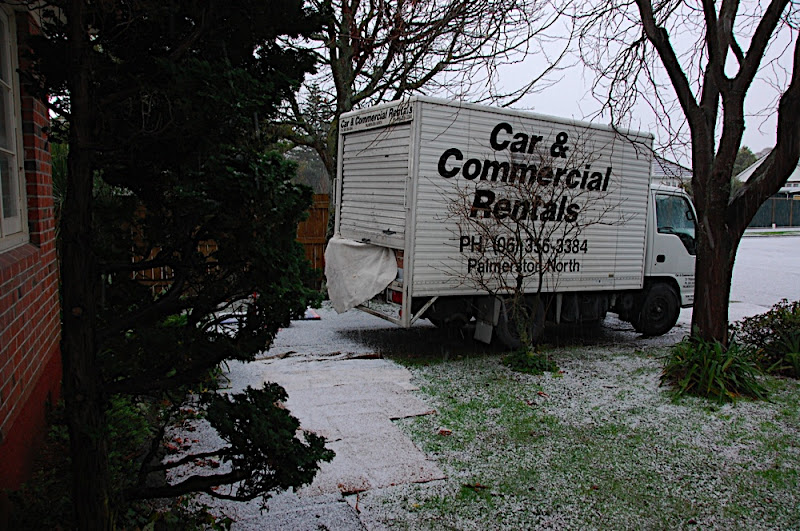
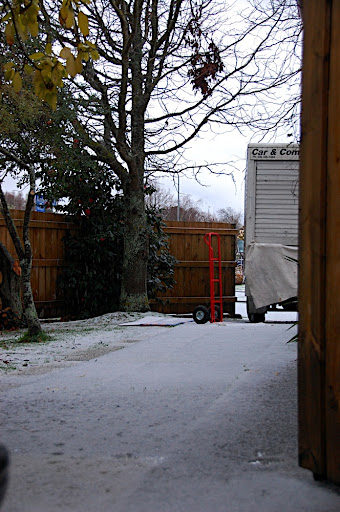
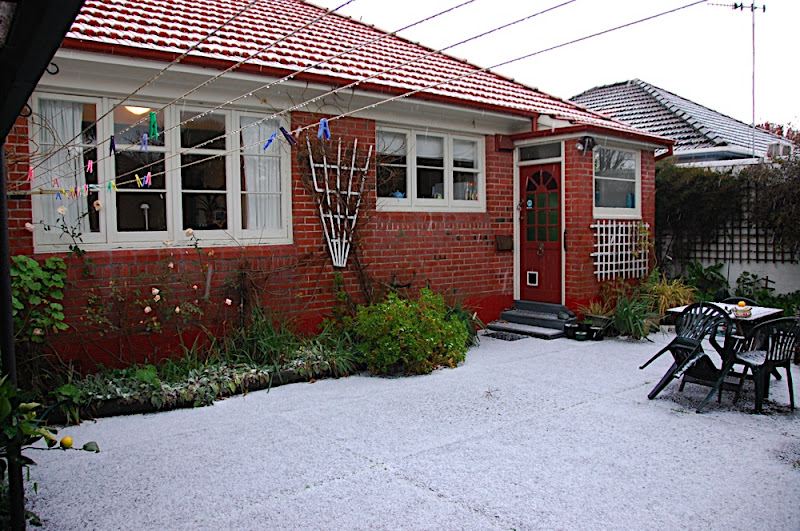

The hail kept up over the Paihiatua track too making a racket on the roof of the truck. Then, once we got into the Wairarapa, it stopped and the sun came out. (The photos from the road are by Aurelie --- just to reassure you that I wasn't shooting from the wheel.)

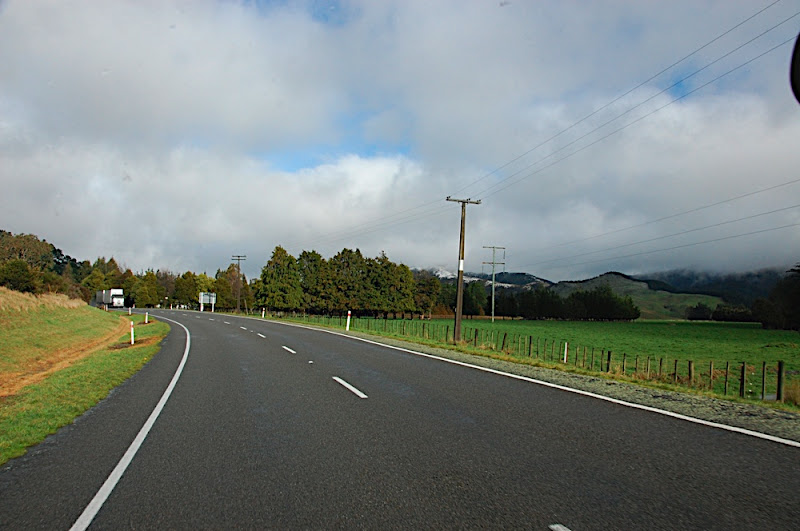
We picked up N from Masterton train station and collected another lot of furniture, a full ute load of it, from a storage place before heading south to Martinborough (with just a quick pause for bread and pastry shopping at The French Baker in Greytown).

The weather held for the drive to Martinborough and as we unloaded the furniture (after a quick lunch by the fire). Then N and Aurelie made a visit to Schoc Chocolates while Lorraine and I collected another truck load of boxes which had been in storage nearby.
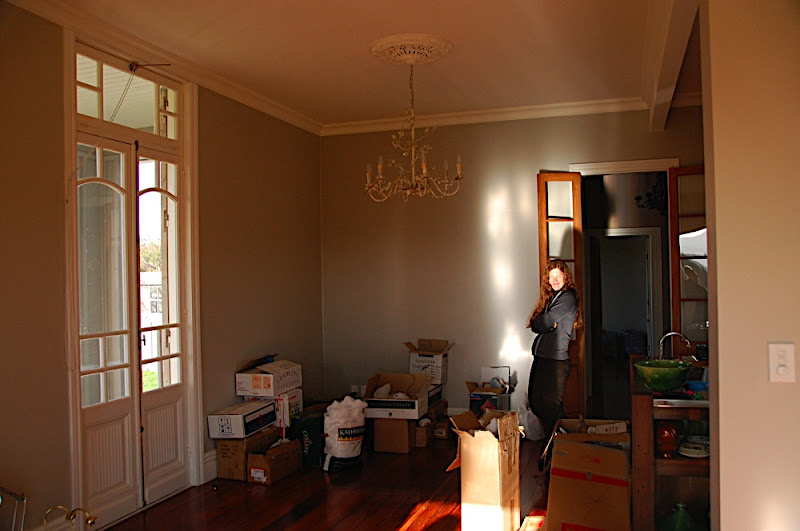
It was dark by the time we had all finished unloading, darker than it was when we had started moving things in the morning, but the new house was warm from the fire and already starting to look a bit like a home with the furniture in it, even if there were something like a hundred boxes still to unpack. Back in P.N. there was still ice on the ground from the morning's hail.
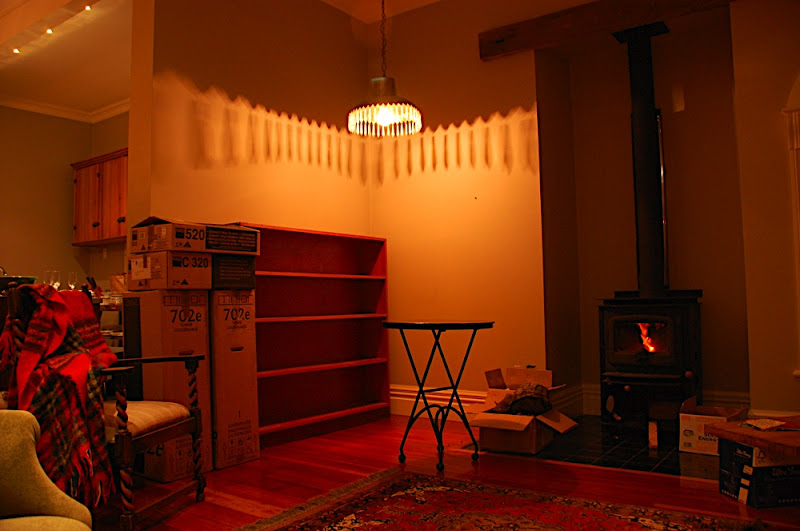
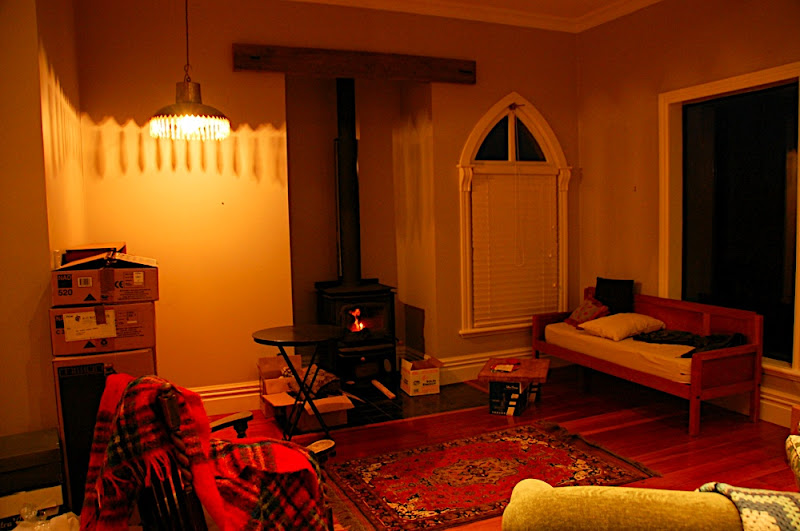
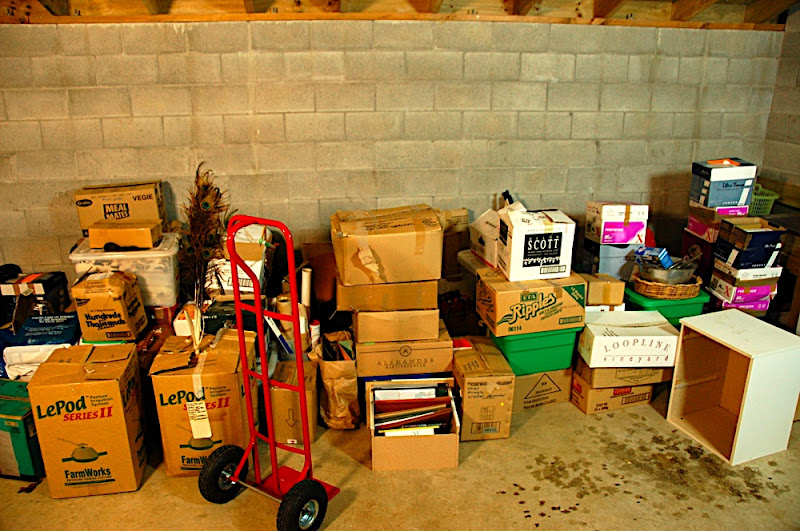
A couple more photos from the day:
The hail kept up over the Paihiatua track too making a racket on the roof of the truck. Then, once we got into the Wairarapa, it stopped and the sun came out. (The photos from the road are by Aurelie --- just to reassure you that I wasn't shooting from the wheel.)
We picked up N from Masterton train station and collected another lot of furniture, a full ute load of it, from a storage place before heading south to Martinborough (with just a quick pause for bread and pastry shopping at The French Baker in Greytown).
The weather held for the drive to Martinborough and as we unloaded the furniture (after a quick lunch by the fire). Then N and Aurelie made a visit to Schoc Chocolates while Lorraine and I collected another truck load of boxes which had been in storage nearby.
It was dark by the time we had all finished unloading, darker than it was when we had started moving things in the morning, but the new house was warm from the fire and already starting to look a bit like a home with the furniture in it, even if there were something like a hundred boxes still to unpack. Back in P.N. there was still ice on the ground from the morning's hail.
A couple more photos from the day:
 |
| 08-07 Moving House |
Subscribe to:
Posts (Atom)